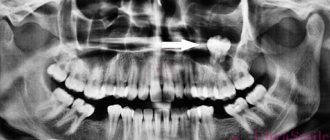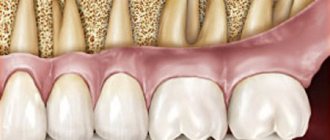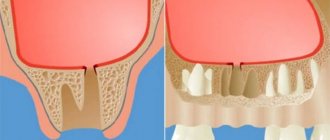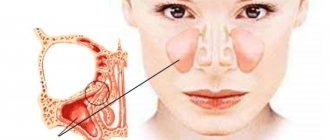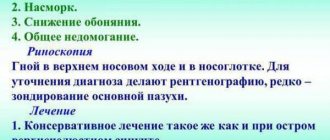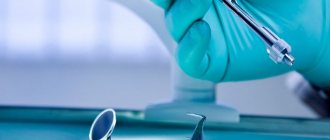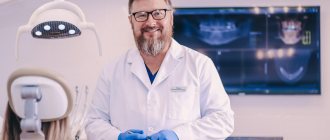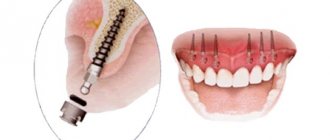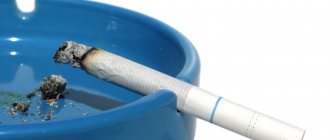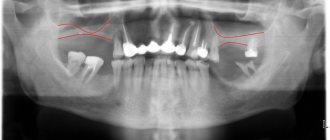A cyst is a benign formation. The presence of a cyst in the maxillary sinus can be indicated by regular headaches and frequent colds. The formation of a cyst occurs at the onset of the inflammatory process, for example, with sinusitis. Without a diagnostic test, it is impossible to identify the disease. Treatment is carried out using different methods, but most often the removal of a cyst in the maxillary sinus occurs through an endoscope.
Main symptoms of damage
The main reason for the accumulation of thick mucus in the nasal cavity and the appearance of a cyst in it is sinusitis. If a person has a deviated nasal septum or other problems in the structure of the jaws, palate, or maxillary sinuses, then he is at particular risk. In this case, radiography or MRI is used to identify the cyst.
The formation is often discovered by accident, since as long as the sinus cavities are not clogged, the patient does not feel any unpleasant symptoms. As the cyst increases in size, it can cause the following unpleasant symptoms:
- pain spreading in the eye area: when you tilt your head, the pain only gets worse;
- pain in the temples and forehead;
- feeling unwell, worsening condition;
- nasal congestion, in some cases only in the nostrils;
- swelling of the nose;
- thick discharge of pus from the nose;
- feeling of mucus running down the back of the throat;
- frequent and prolonged colds.
- pronounced facial asymmetry;
- displacement of the eyeball;
- pain in teeth and gums;
- pressure in the eyes and nose.
- meningitis;
- sepsis;
- deformation of the facial structure;
- vision problems;
- necrosis of bone tissue.
If the cyst has managed to grow to a large size, the patient complains of the following problems:
The cyst itself provokes the appearance of the same symptoms as sinusitis. A small formation can lead to serious complications and endanger the life and health of the patient. But if the size of the formation begins to increase, the doctor will prescribe a mandatory operation to remove the cyst in the maxillary sinus. If the symptoms of the disease are ignored, the patient may experience the following complications:
If the tumor in the maxillary sinuses has become too large and causes discomfort, then it is important for the patient to undergo surgery to remove the maxillary sinus cyst. Rehabilitation after surgery to remove a cyst does not last long. The cost of the operation varies from 5,000 to 20,000 rubles, depending on the chosen method.
In reviews of the removal of maxillary sinus cysts, patients note the safety and painlessness of the procedure. In case of surgery, the doctor removes all the mucus and phlegm accumulated in the sinuses. The maxillary sinus cyst goes away after the operation, there is no previous discomfort, and the risk of complications in the future is reduced.
Indications for maxillary sinusotomy
Indications for the use of maxillary sinusotomy are quite varied:
- chronic sinusitis;
- cysts of the upper jaw;
- nasal polyps;
- benign tumors;
- foreign bodies in the maxillary sinus: remains of filling material, tooth roots, particles of intraosseous implants;
- blood clots;
- damage to the walls of the maxillary sinus.
If a malignant tumor is suspected in the maxillary sinus, a biopsy is performed during maxillary sinus.
The main reasons for the appearance of formations
A cyst in the maxillary sinuses appears as a result of complete occlusion or significant problems with the outflow of secretions from the gland (which regularly produces mucus). In the international classification of the disease, a maxillary sinus cyst is classified as a retention disease.
The main reasons for the appearance include:
The main etiological cause of the appearance of maxillary sinus cysts is sinusitis. This condition is usually provoked by an inflammatory process, leading to severe swelling of the mucous membrane. Such conditions are favorable for blockage of the excretory ducts and the formation of a large number of cysts in both the right and left sinuses. If sinusitis is detected, the doctor must conduct a radiological examination.
Rare risks of endoscopic sinus surgery
Strongly depend on individual characteristics and the area of the sinus:
- Formation of blood clots (hematoma).
- Decreased sense of smell.
- Trigeminal nerve irritation or trigeminal neuralgia.
- Injury to the tear duct.
- Hemorrhage in the orbit.
In the first few days after surgery, the nasal airways may become blocked due to swelling, leading to a feeling of nasal congestion. In addition, bloody “crusts” can form on the nasal mucosa and increase the feeling of itching in the nasal cavity. Rare complications include recurrent bleeding, loss of smell, increased neuralgic pain, inflammation due to secretion accumulation, and minor bruising under the eyes.
Carrying out the operation
There is no specific size of cyst for removal from the maxillary sinus. Everything is individual. Surgery is important to eliminate severe neoplasms. Such a cyst can significantly decrease in size if a puncture is performed, during which its contents are eliminated through a puncture. But the disease will still remain and will begin to appear again over time.
If the formation significantly increases in size, it can completely block the access of air to the cavity of the maxillary sinus, and also worsen the condition of the blood vessels. In this case, the doctor prescribes surgical intervention, since it is impossible to cure such a formation with the help of medications.
The quality of the procedure performed will directly depend on the following factors:
There are several ways to remove a maxillary sinus cyst. Efficiency has been proven by many years of practice. Judging by the reviews, removal of a maxillary sinus cyst has positive results.
Main types of operations
Before starting treatment for a cyst, it is important to carry out all the necessary diagnostic measures. To do this, it is mandatory to take x-rays and visit an otolaryngologist. After identifying the main cause of the cyst, the doctor prescribes correct and effective treatment. For example, one of the reasons for the appearance of a cyst can be dental disease. After visiting the dentist and eliminating the main cause of the disease, the disease will go away on its own.
If the tumor was discovered by chance during a tomography of the skull, and it does not cause any unpleasant sensations, then treatment for the cyst may not be prescribed. But if it begins to actively develop, then it is important to remove it as soon as possible.
To remove a cyst of the left maxillary sinus, the following operations are performed:
- Piercing the tumor. In this case, the entire contents of the cyst are removed from the nasal sinuses, preserving its membrane. It is important to remember that when choosing this method there is a risk of filling it again.
- Caldwell-Luc operation. This method has been used in medical practice for a long time. It is used only for chronic purulent inflammation. Pain relief is carried out by administering novocaine. In this case, there is a high risk of injury.
- Denker's operation. The autopsy is performed on the face.
- Operation with an endoscope. It is considered safer and less traumatic. No incisions are made on the face. Removal of a cyst in the maxillary sinus occurs using an endoscope directly through the nose.
Many patients are afraid of surgery, especially after watching a video on cyst removal. It is important to remember that the doctor prescribes surgery only in cases of special need. This disease does not have clearly defined symptoms and often goes away on its own without outside intervention. But if the atheroma continues to increase in size, it is important to remove it immediately.
The method of removing the cyst is chosen only by the doctor after diagnosis. No folk remedies or physiotherapeutic procedures can be used, and heating can only worsen the condition.
Course of the postoperative period
After removal of the cyst by classical maxillary sinusotomy, which is a full-fledged abdominal operation, the patient must adhere to bed rest for 3 to 5 days.
After endoscopic microsinusrotomy without a puncture, the patient leaves the hospital or clinic after 2 - 3 hours, but if a puncture was made in the anterior wall of the sinus (in the mouth), then the period of primary rehabilitation is extended to 1 - 2 days and a sick leave certificate is issued for several days to comply with the home regime . At this time, blowing your nose, heating the nose, physical stress, taking hot baths, visiting saunas, baths and swimming pools is not allowed to avoid bleeding, increased swelling and possible infection.
After surgery to remove a cyst of the paranasal sinus, swelling of the mucous membrane is observed for 1 to 3 months (depending on the technique used), to relieve which the doctor may prescribe hormonal nasal medications. Glucocorticosteroids used locally are not absorbed into the blood and do not produce side effects.
If the Callwell-Luc technique was used, then up to 2–3 months, nasal discharge is observed, as well as mild numbness of the skin of the nasolabial triangle, cheeks and gums due to the involvement of the nerve branches.
To prevent inflammatory phenomena and relieve pain, Ketorol, Nimesil, vasoconstrictors and antiallergic drugs are used. According to indications, antibiotic drugs and physiotherapy are prescribed to reduce swelling and accelerate regeneration. All patients should chew food on the side opposite to the one where treatment was carried out and rinse the mouth with Chlorhexidine several times a day.
The entire recovery period should take place under the constant supervision of an otolaryngologist and radiography.
Possible postoperative complications
Postoperative complications are more likely if a radical technique was used, and abnormal conditions occur much less frequently after endoscopy.
The most common:
- damage to the trigeminal nerve with pain or decreased sensitivity of the facial skin on the side of treatment;
- formation of a fistula (hole) in the sinus cavity;
- bleeding that is prevented using nasal tamponade (more often occurs with reduced blood clotting or taking anticoagulants such as Warfarin);
- deterioration in general health caused by a reaction to local or general anesthesia;
- addition of bacterial infection and inflammatory complications;
- leakage of cerebral liquor due to a violation of the integrity of the sphenoid and ethmoid sinuses (usually stopped during surgery);
- decreased sense of smell when certain areas of the nasal cavity are damaged;
- change in voice timbre;
- development of chronic rhinitis, sinusitis (after a radical method).
If an infection attaches to the cystic capsule, pus begins to actively accumulate in it. As a result, the formation may burst, which will lead to serious consequences and complications.
Endoscopic surgery
Endoscopic removal of a maxillary sinus cyst has its advantages compared to other types of surgery:
Before surgery, the patient is prohibited from eating for seven hours and drinking for two hours. Endoscopic removal of a maxillary sinus cyst is performed under local anesthesia. In rare cases, specialists use general anesthesia. The operation time is approximately 30 minutes. The puncture diameter is minimal - only 5 mm.
An endoscope is inserted through the puncture and the maxillary cyst in the maxillary sinus is removed. The procedure is monitored by the doctor on the monitor. The cost of such an operation varies from 10,000 to 20,000 rubles. The price includes hospital stay and collection of all necessary tests. Removal of a maxillary sinus cyst in Moscow may cost more. It all depends on the choice of clinic.
After removal of the maxillary sinus cyst, the patient should be observed every month by an ENT specialist. The specialist prescribes medications that will help the patient’s body recover quickly. During the recovery period, the patient is prohibited from eating hot, spicy, smoked or too cold food. It is prohibited to visit the swimming pool, bathhouse and sauna. It is recommended to spend time in a medical sanatorium.
Rehabilitation after maxillary sinusotomy
In the period after surgery, the patient may need tamponade on the operated side for 8-24 hours. After endoscopic maxillary sinusotomy, it is enough to take painkillers according to the regimen prescribed by the attending physician.
It is necessary to maintain oral hygiene: brush your teeth, gargle with antiseptics and follow all consultations with your doctor.
After studying the reviews about sinusotomy, you can understand whether maxillary sinusotomy is right for you. The price depends on the choice of operation.
Laser removal
Many patients are confident that cyst removal using a laser is painless and bloodless. But this opinion is wrong, since during the operation the doctor makes punctures in the right places.
This can be explained by the fact that many patients confuse laser therapy and laser surgery. Although laser is common in medical practice, including ENT therapy, it is not a very good solution for treating sinusitis. The main problems that may arise during the operation:
- The laser needs to be brought very close to the formation itself, and for this it needs to get into the maxillary sinus itself. To do this you need to make a puncture.
- The total laser diameter reaches 600 micrometers. Removing a cyst is a labor-intensive process.
- The laser temperature can reach up to 300 degrees. Despite anesthesia, the patient may sometimes experience severe pain and discomfort during the procedure.
The main advantage of laser removal is that it is bloodless and has a short recovery period. But today it is more rational to eliminate a cyst in the maxillary sinuses using an endoscope, which has been confirmed by many doctors. Experts recommend removal of a maxillary sinus cyst in Tambov.
Types of maxillary sinusotomy
There are classical (radical) maxillary sinusotomy and endoscopic maxillary sinusotomy.
Radical maxillary sinusotomy
The maxillary sinus operation is used to open the maxillary sinus through the mouth.
Radical maxillary sinusotomy is carried out using local or general (as indicated) anesthesia and includes the creation of access, excision of soft tissue, opening of the maxillary cavity and removal of polyps or foreign objects, formation of an anastomosis connecting the maxillary sinus with the lower nasal passage. The operation takes about an hour.
1 Radical maxillary sinusotomy in MedicCity
2 Radical maxillary sinusotomy in MedicCity
3 Radical maxillary sinusotomy in MedicCity
The essence of the operation
With an intraoral gairotomy, the otolaryngologist makes a horizontal incision in the soft tissues of the upper gum and moves them upward. Then, using special instruments, part of the bone plate on the facial wall of the maxillary sinus is removed. Thanks to the hole made, the sinus cavity becomes accessible for manipulation, and the otolaryngologist removes the pathological contents using a sharp spoon.
After scraping the mucous membrane, an anastomosis is formed with the nasal cavity, smoothing out the bone defect. A flap is made from the remaining free mucosa and placed on the bottom of the maxillary sinus to restore epithelization of its walls.
At the end of the operation, a tampon is placed in the sinus, which is removed into the nasal passage, and the wound on the side of the mouth is sutured. Using a tampon, sterility of the sinus is achieved and the accumulation of blood and pus is prevented.
After 48 hours, after preliminary anesthesia, the tampon is removed, and the patient is prescribed vasoconstrictor drops and sinus lavage. After a week, the sutures in the mouth are removed.
Endoscopic maxillary sinusotomy
Endoscopic maxillary sinusotomy is very popular as a minimally invasive and more gentle technique. With endoscopic maxillary sinusotomy, the lip is not dissected; the operation is performed through the nose. The procedure is virtually painless, characterized by minor swelling after surgery and does not leave scars.
Endoscopic maxillary sinusotomy. Its advantage over conventional surgery:
- low morbidity;
- minimal blood loss;
- the ability to perform surgery on an outpatient basis;
- quick rehabilitation period for the patient;
- absence of cosmetic defect after surgery.
The essence of endoscopic maxillary sinusotomy
This type of operation is performed under local anesthesia using special endoscopic equipment through the nose.
The indication for endoscopic maxillary sinus, as well as for conventional surgery, is a severe purulent process in the maxillary sinus, for which conservative treatment has proven ineffective.
The duration of endoscopic maxillary sinusotomy is 20 minutes. The opening of the maxillary cavity occurs through the nose, and not an incision is made, but a minimal puncture with a diameter of about 5 mm. An endoscopic tube is inserted into this incision, and foreign objects and pathogenic material are removed using suction. All manipulations are performed under the control of an endoscope.
The following methods of endoscopic access to the maxillary cavity exist:
- through the middle nasal meatus;
- through the lower nasal passage;
- through the anterior stack of the sinus;
- through the alveolus of the tooth (if there is a fistula);
- through the tubercle of the maxilla.
1 Diagnosis of sore throat
2 Diagnosis of sore throat
3 Diagnosis of sore throat
The use of endoscopic maxillary sinusotomy helps reduce trauma to surrounding tissues and speed up rehabilitation after surgery.
With the help of endoscopic maxillary sinusotomy, it is possible to avoid the feeling of numbness in the teeth on the operated side, which the patient experiences during a conventional operation.
Highly qualified otolaryngologists of the Multidisciplinary Clinic "MedicCity" will help you in solving various ENT problems. We possess all modern methods of diagnosing and treating diseases of the ear, nose and throat.
Operation Denker
The Denker operation is a procedure that is not particularly different from the Caldwell-Luc operation. This method is also considered quite outdated and is performed under general anesthesia. During the Caldwell-Luc procedure, an incision is made in the upper jaw under the lip. Denker's operation is characterized by an incision through the frontal facial wall. All other actions will be the same.
This method of removing a cyst from the maxillary sinus is chosen when the formation requires radical intervention, for example, when it forms on the back wall of the sinus. In this case, only Denker’s operation allows free manipulation and complete elimination of the formation. Of course, such a procedure is quite traumatic. Its main disadvantages include the following:
The main advantages of the procedure include:
Most often, Denker's operation is the only method to eliminate a large cyst in the maxillary cavity. Doctors advise removal of the maxillary sinus in Moscow.
Possible complications after surgery
Any surgical intervention always carries certain risks. The patient must understand that even a professional cannot guarantee 100% success during the operation. After surgery, there is a risk of the following complications:
The rehabilitation period after removal of a cyst in the maxillary sinuses continues for several weeks. It is important to clean the stitches and rinse the sinuses daily. The treating specialist also prescribes antibiotics, antihistamines and painkillers. The stitches are allowed to be removed after a week. The rehabilitation itself can last a month.
Contraindications
Surgery for a cyst in the nose is not a necessary intervention, so the surgeon must weigh all the positive and negative aspects of the procedure.
Surgery to remove a tumor in the sinus is a risk for a person. For some diseases, surgery is not performed. These include:
Contraindications include poor blood clotting.
- infectious process in the body;
- pathologies of the cardiovascular system, liver, kidneys in the decompensated stage;
- poor blood clotting;
- epileptic seizures;
- malignant tumors.
Unpleasant symptoms
The patient may experience the following unpleasant symptoms:
After endoscopic surgery to remove a maxillary sinus cyst, the patient may be sent home and scheduled for examination the next day. The risk of complications is significantly reduced, and recovery time is reduced. There are many good reviews about the procedure for removing a maxillary sinus cyst at Burnazyan’s clinic. If you wish, you can ask for help there.
Preventive measures
A cyst in the maxillary sinus appears as a result of complications from diseases of the nose and nasopharynx. To avoid this condition, it is important to carefully monitor your health and begin timely treatment for colds, runny nose and sinusitis. You should not put off visiting the dentist.
Simple caries can provoke the appearance of pulpitis or suppuration. If the patient is concerned about chronic diseases, then it is important to keep them under control and prevent complications. If there is a deviated septum, it is important to correct this problem. If there are polyps in the nose, they are removed. To prevent cysts you need:
If a cyst does occur, you should immediately seek help from a doctor and carefully monitor the treatment process. If discomfort or discomfort occurs, it is important to remove the cyst immediately.
